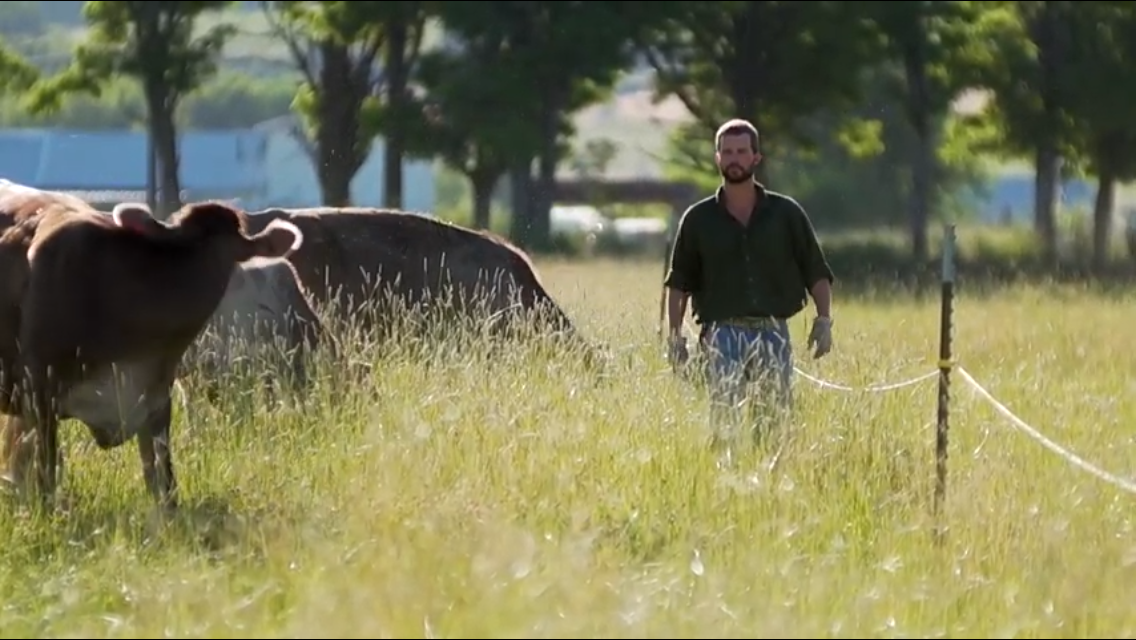Saint John’s cows grazing on lush, green grass.
We’ve heard much in the media over the years of the environmental harm caused by the beef industry, and that the trend of humanity toward vegetarianism - or even veganism - is inevitable. While we share a common concern for environmental sustainability with our vegetarian and vegan friends, we would like to offer a different (and we hope very interesting) view on how cultivating grass fed beef may be a valuable part of the effort to care for the environment and all the ecosystems of the earth.
Without further ado, here are a few ways grass fed beef’s environmental impact contributes to multi-generational sustainability and regeneration.
Organic and Grass-Fed Environmental Practices
At a baseline, the USDA organic certification requires that no commercial petrochemicals, fertilizers, pesticides, or herbicides are used on our pastures, and that everything the animals eat are GMO-free. Our cows are grass-fed and pasture-raised. When cows are confined to a feedlot, unsanitary conditions for the cows and high concentrations of animal waste runoff pollutes groundwater and surface streams and rivers. Beyond the organic concentrates from the animals themselves, there is almost always a large amount of antibiotic and drug content in the runoff since the beef are highly medicated to attempt to ward off disease in those atrocious conditions. Conventional agricultural practices also cause a loss of habitat for important wildlife ecology. Our organic and grass-fed practices protect wildlife, water purity, air quality, and soil health for future generations.
How We Take Environmental Stewardship A Step Further
Saint John’s cows grazing and lazing.
Because we are a small, grass-fed, and organic family farm, we know our animals and land in great detail. We care for our animals and land with attention and love, and we are able to react to the individual needs of our animals. Our regenerative practices are proactive: we tend and build soil, foster diversity and nutrient density, and encourage quality of life for our land and animals. We want the best nutrition for our cows, so we grow a widely diverse mix of grasses, legumes, and herbs that provide complementing nutritional strengths.
With a small scale local, organic farm, there is much more transparency. There are factory farms that are certified organic, but it’s still factory farming. Conventional agriculture practices do not create the best quality of life for animals or the environment, nor do these practices create as high quality of a product. Beyond organic and grass-fed, it’s also necessary to consider the aspect of local farms. Food grown local to you contains custom specific nutrients and micro-nutrients that fit specific needs of the animals and people in their local environment.
“We care for animals with dignity and respect, and steward the soil for the health of the planet, the animals, and ourselves.”
Grass Fed Beef, Greenhouse Gases, and Carbon Sequestration
Everything we eat has an impact on the environment. Although cattle produce methane and use carbon, they also provide significant nutrition per unit mass. All foods have a carbon and greenhouse gas emission -- whether you examine an omnivorous, vegetarian, or vegan diet. According to Dr. Jude Capper, “Although all foods vary in greenhouse gas emissions, it’s also important to look at the bigger picture – we need to account for the nutritional value of foods as well as the greenhouse gas emission. For example, lettuce may have a lower carbon footprint per pound than beef, but beef provides far more nutrients per unit of mass. Furthermore, we need to look at the bigger environmental picture – biodiversity, water use, land use and many other factors need to be considered, not just greenhouse gases.”
Contrary to popular belief, grass fed beef may be a net carbon sink. The keys to putting carbon back into the ground is to prevent overgrazing and over-tilling. When plants are not tilled, their root structures can grow several feet deep, sometimes up to 12 feet below the surface. These roots are essential to break up compacted soil, build topsoil, and sequester carbon. When pastures are overgrazed, the plants can be killed and the soil is negatively affected. When enough grazing has occurred and the ground has been fertilized by the cow’s manure, the plants are stimulated to grow and this is where regeneration happens.
A study from Michigan State compared the effect of conventional feedlot agriculture and adaptive multi-paddock grazing (a strategy using fencing to move cows from section to section to prevent overgrazing) on the carbon lifecycle over a period of 4 years. The study concluded that while the feedlot system produced fewer greenhouse gases, multi-paddock grazing produced a net carbon sink. The cows put carbon back into the soil! This means that well managed farms, working in harmony with nature, can be a net positive to our environment. This is the small, organic, grass-fed difference.
Our organic, grass-fed beef farm works in tandem with nature to regenerate soil, maintain wildlife ecology, protect water and air quality, and put carbon back into the earth.
References
Share the Gift, Aaron F. Dill
Nourishing Traditions, Sally Fallon Morell
https://www.sciencedirect.com/science/article/pii/S0308521X17310338
https://www.bestfoodfacts.org/are-cows-bad-for-the-environment/






































